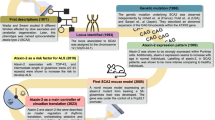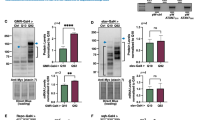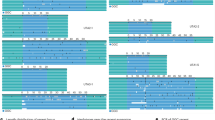Abstract
A growing number of human neurodegenerative diseases result from the expansion of a glutamine repeat in the protein that causes the disease1. Spinocerebellar ataxia type 1 (SCA1) is one such disease—caused by expansion of a polyglutamine tract in the protein ataxin-1. To elucidate the genetic pathways and molecular mechanisms underlying neuronal degeneration in this group of diseases, we have created a model system for SCA1 by expressing the full-length human SCA1 gene in Drosophila. Here we show that high levels of wild-type ataxin-1 can cause degenerative phenotypes similar to those caused by the expanded protein. We conducted genetic screens to identify genes that modify SCA1-induced neurodegeneration. Several modifiers highlight the role of protein folding and protein clearance in the development of SCA1. Furthermore, new mechanisms of polyglutamine pathogenesis were revealed by the discovery of modifiers that are involved in RNA processing, transcriptional regulation and cellular detoxification. These findings may be relevant to the treatment of polyglutamine diseases and, perhaps, to other neurodegenerative diseases, such as Alzheimer's and Parkinson's disease.
This is a preview of subscription content, access via your institution
Access options
Subscribe to this journal
Receive 51 print issues and online access
We are sorry, but there is no personal subscription option available for your country.
Buy this article
- Purchase on SpringerLink
- Instant access to full article PDF
Prices may be subject to local taxes which are calculated during checkout





Similar content being viewed by others
References
Cummings, C. J. & Zoghbi, H. Y. Fourteen and counting: unraveling trinucleotide repeat diseases. Hum. Mol. Genet. 9, 909–916 ( 2000).
Brand, A. & Perrimon, N. _targeted gene expression as a means of altering cell fates and generating dominant phenotypes. Development 118, 401–415 ( 1993).
Warrick, J. M. et al. Suppression of polyglutamine-mediated neurodegeneration in Drosophila by the molecular chaperone HSP70. Nature Genet. 23, 425–428 ( 1999).
Jackson, G. R. et al. Polyglutamine-expanded human huntingtin transgenes induce degeneration of Drosophila photoreceptor neurons. Neuron 21, 633–642 (1998).
Kazemi-Esfarjani, P. & Benzer, S. Genetic suppression of polyglutamine toxicity in Drosophila. Science 287, 1837–1840 (2000).
Marsh, J. L. et al. Expanded polyglutamine peptides alone are intrinsically cytotoxic and cause neurodegeneration in Drosophila. Hum. Mol. Genet. 9, 13–25 (2000).
Lin, X., Cummings, C. J. & Zoghbi, H. Y. Expanding our understanding of polyglutamine diseases through mouse models. Neuron 24, 499– 502 (1999).
Moses, K. & Rubin, G. M. Glass encodes a site-specific DNA-binding protein that is regulated in response to positional signals in the developing Drosophila eye. Genes Dev. 5, 583– 593 (1991).
Burright, E. N. et al. SCA1 transgenic mice: a model for neurodegeneration caused by an expanded CAG trinucleotide repeat. Cell 82, 937–948 (1995).
Klement, I. A. et al. Ataxin-1 nuclear localization and aggregation: role in polyglutamine-induced disease in SCA1 transgenic mice. Cell 95, 41–53 (1998).
Cummings, C. J. et al. Mutation of the E6-AP ubiquitin ligase reduces nuclear inclusion frequency while accelerating polyglutamine-induced pathology in SCA1 mice. Neuron 24, 879–892 (1999).
Rorth, P. et al. Systematic gain-of-function genetics in Drosophila. Development 125, 1049–1057 (1998).
Chai, Y., Koppenhafer, S. L., Bonini, N. M. & Paulson, H. L. Analysis of the role of heat shock protein (Hsp) molecular chaperones in polyglutamine disease. J. Neurosci. 19, 10338– 10347 (1999).
Salinas, A. E. & Wong, M. G. Glutathione S-transferases–a review. Curr. Med. Chem. 6, 279– 309 (1999).
Bodoor, K. et al. Function and assembly of nuclear pore complex proteins. Biochem. Cell Biol. 77, 321–329 (1999).
Grams, R. & Korge, G. The mub gene encodes a protein containing three KH domains and is expressed in the mushroom bodies of Drosophila melanogaster. Gene 215, 191– 201 (1998).
Lin, X., Antalffy, B., Kang, D., Orr, H. T. & Zoghbi, H. Y. Polyglutamine expansion down-regulates specific neuronal genes before pathologic changes in SCA1. Nature Neurosci. 3, 157–163 (2000).
Waragai, M. et al. PQBP-1, a novel polyglutamine tract-binding protein, inhibits transcription activation by Brn-2 and affects cell survival. Hum. Mol. Genet. 8, 977–987 ( 1999).
Boutell, J. M. et al. Aberrant interactions of transcriptional repressor proteins with the Huntington's disease gene product, huntingtin. Hum. Mol. Genet. 8, 1647–1655 ( 1999).
Masliah, E. et al. Dopaminergic loss and inclusion body formation in alpha-synuclein mice: implications for neurodegenerative disorders. Science 287, 1265–1269 (2000).
Harel, A. et al. Persistence of major nuclear envelope antigens in an envelope-like structure during mitosis in Drosophila melanogaster embryos. J. Cell Sci. 94, 463–470 ( 1989).
Acknowledgements
We thank M. Mancini for help with the confocal microscope; K.-W. Choi and members of his laboratory for help with the eye sections; C. Cummings for advice and insightful discussions; V. Brandt for editorial help; M. Magarinos and P. Herrero for help with the initial fly screens; R. Davis and A. L. Beaudet for reading the manuscript; C. Cater, G. Rubin, D. Cribbs, R. Davis, T. Aigaki, H. Steller, G. Pennetta, S. Parkhurst and the Bloomington Stock Center for fly strains; and M. Levine and R. Wharton for antibodies. This work was supported by a grant of the NIH to J.B. J.B. is also grateful for initial support by the Banco Bilbao Vizcaya. M.L.N.-R. was supported by an HHMI postdoctoral fellowship for physicians. H.Y.Z. is a Howard Hughes Medical Institute Investigator.
Author information
Authors and Affiliations
Corresponding author
Supplementary information
Supplementary Information
Supplementary Information
Rights and permissions
About this article
Cite this article
Fernandez-Funez, P., Nino-Rosales, M., de Gouyon, B. et al. Identification of genes that modify ataxin-1-induced neurodegeneration . Nature 408, 101–106 (2000). https://doi.org/10.1038/35040584
Received:
Accepted:
Issue Date:
DOI: https://doi.org/10.1038/35040584
This article is cited by
-
Preclinical dose response study shows NR2E3 can attenuate retinal degeneration in the retinitis pigmentosa mouse model RhoP23H+/−
Gene Therapy (2024)
-
Modifier pathways in polyglutamine (PolyQ) diseases: from genetic screens to drug _targets
Cellular and Molecular Life Sciences (2022)
-
Consensus Paper: Strengths and Weaknesses of Animal Models of Spinocerebellar Ataxias and Their Clinical Implications
The Cerebellum (2022)
-
Nr2e3 is a genetic modifier that rescues retinal degeneration and promotes homeostasis in multiple models of retinitis pigmentosa
Gene Therapy (2021)
-
Glial AP1 is activated with aging and accelerated by traumatic brain injury
Nature Aging (2021)



